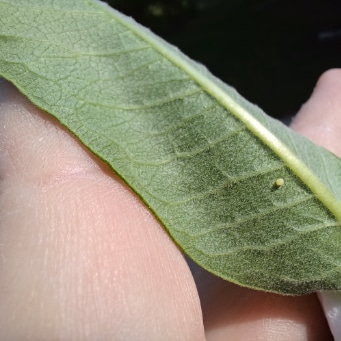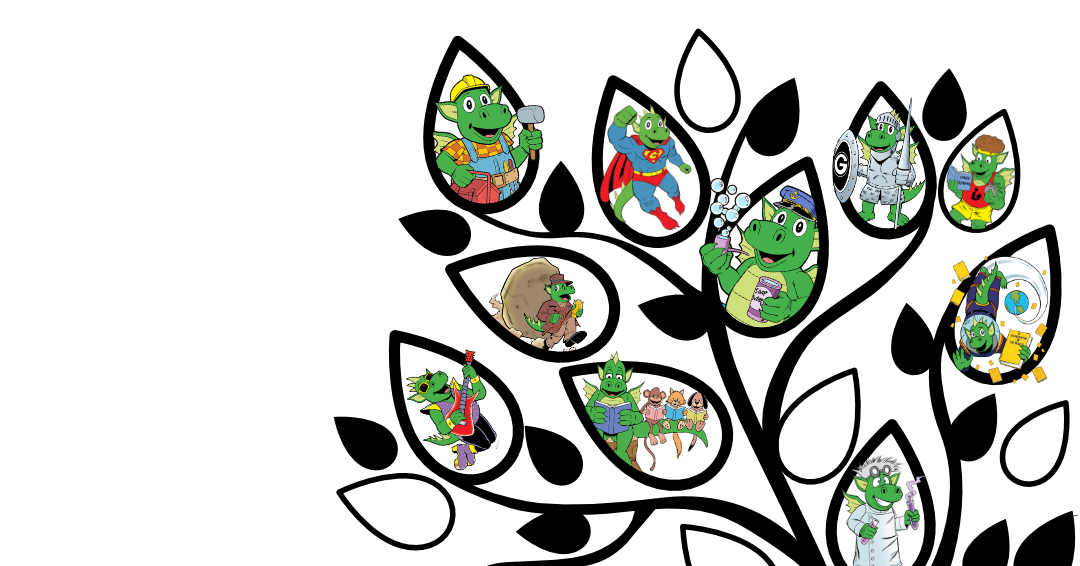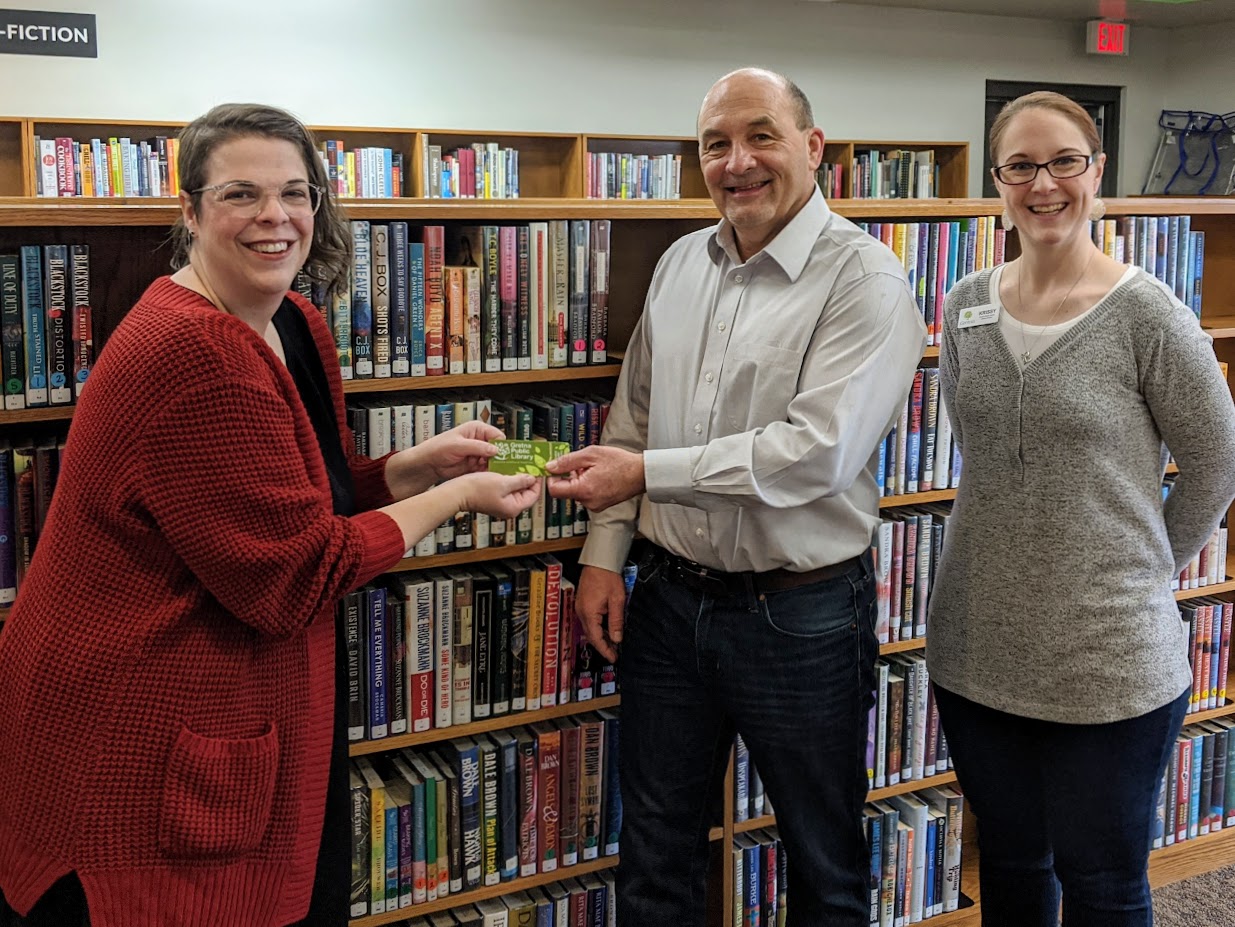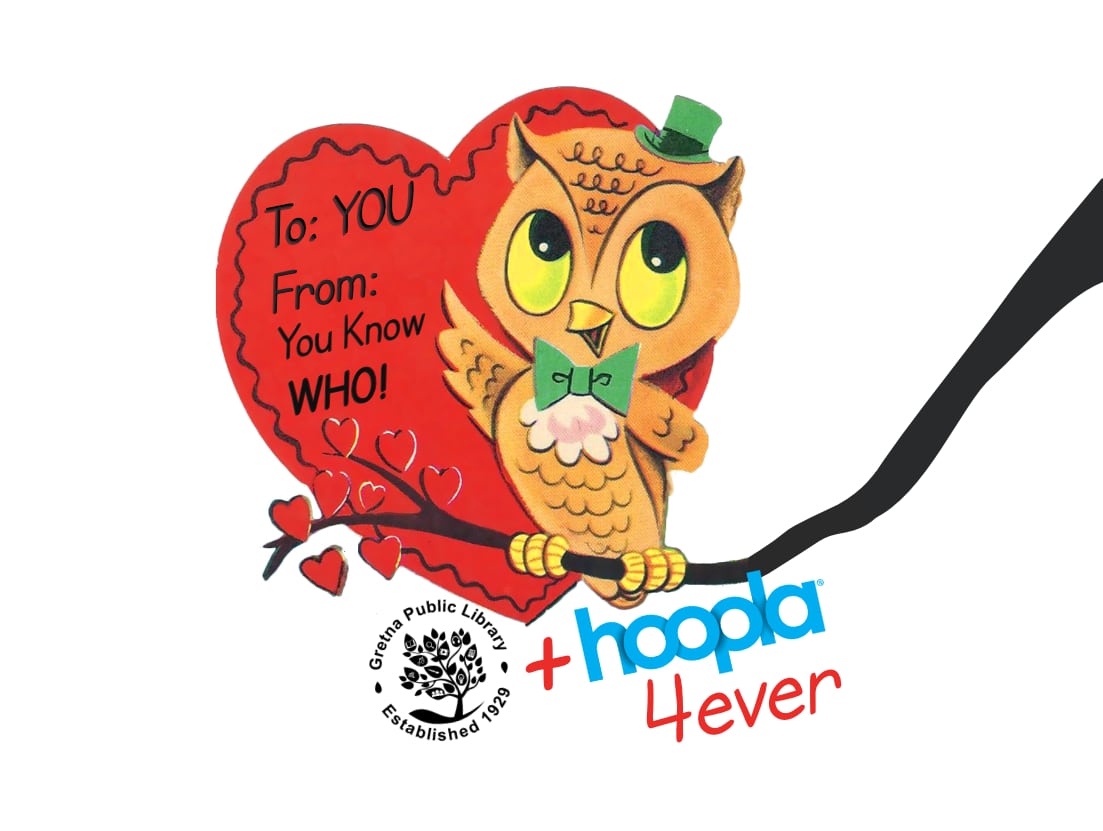Monarch Mini-Mania: The Complete Series
GPL Librarians have all sorts of interests, and we thought it’d be fun to share one. Assistant Library Director Rebecca McCorkindale has had an enduring love of all things monarch butterfly since she was a little girl. After discovering a monarch egg in her backyard this morning, she thought that a series on this butterfly’s development would be both fun and entertaining.
We’re calling this event a mini mania since it will be a single monarch getting this treatment. Captive rearing isn’t recommended on a large scale, but doing this with one or two monarchs for educational purposes is great. It’s one thing to read about a subject, and a whole different experience when you’re involved.
This post will be updated at different stages of this insect’s life, as well as on GPL’s Facebook page, with photos, facts, and videos. Feel free to ask questions on Facebook and Rebecca will answer as soon as possible. If you or your family would like to see the egg/larva/pupa, then stop by the Children’s Library Tues-Sat during its business hours and ask to see it.
Rebecca also highly recommends Monarch Joint Venture as a place to see more monarchs, get involved, and learn more about this amazing insect.
Thursday, May 25th
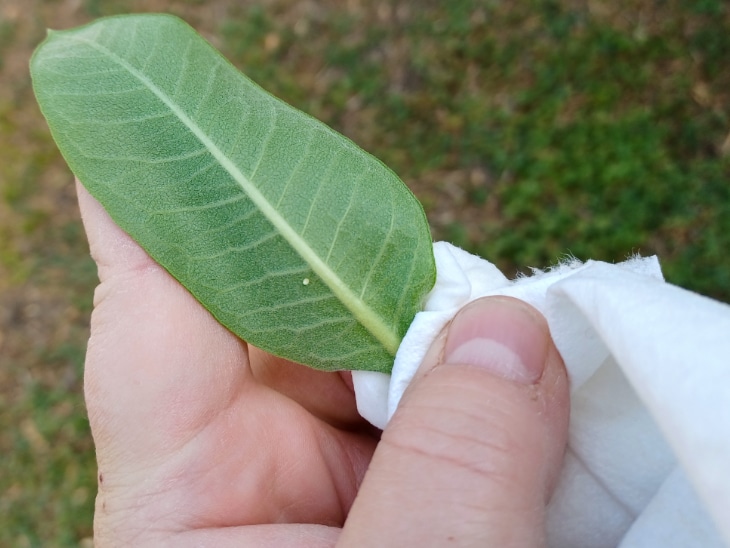
This morning I took a casual look at the seven young common milkweed plants in my backyard, and was pleasantly surprised to find a single egg. I would guess that the female butterfly realized that there would be only food enough for one caterpillar, and we know how very hungry caterpillars can be.
The undersides of common milkweed are very fuzzy undersides of common milkweed. With leaves this young, they really are soft.
For a better look at monarch eggs, visit monarchjointventure.org.
After pulling off the milkweed leaf containing the egg, I carefully cut around the egg and placed it on a damp paper towel. It’s damp to help keep the leaf snippet from drying out too fast. I wrapped the rest of the leaf in a damp paper towel and refrigerated it in hopes that it will still be good for when the caterpillar is hungry. Often it’s too old, but it’s worth attempting.
Then I have my “nursery” that I carry it around in to monitor it and make sure it’s doing okay. The monarch will spend all of its early stages in this nursery, and will be released from it as soon as it’s ready to fly away.

The tiny larva growing in the egg will emerge somewhere within the next 3-5 days, and that’s where the real fun begins – but I don’t want to get ahead of myself.
This egg will be under my supervision at the Children’s Library Tuesdays through Saturdays. Feel free to ask to see it whenever we’re open and I’m here. Or give us a call before stopping by, and we’ll let you know if the caterpillar is available for viewing.
Keep checking back for updates! The title will be adjusted as the updates occur; that’s why we put the date in the title of this post.
Saturday, May 27th
The big moment for this itty-bitty larva occurred this morning: they ate their way out of their egg!
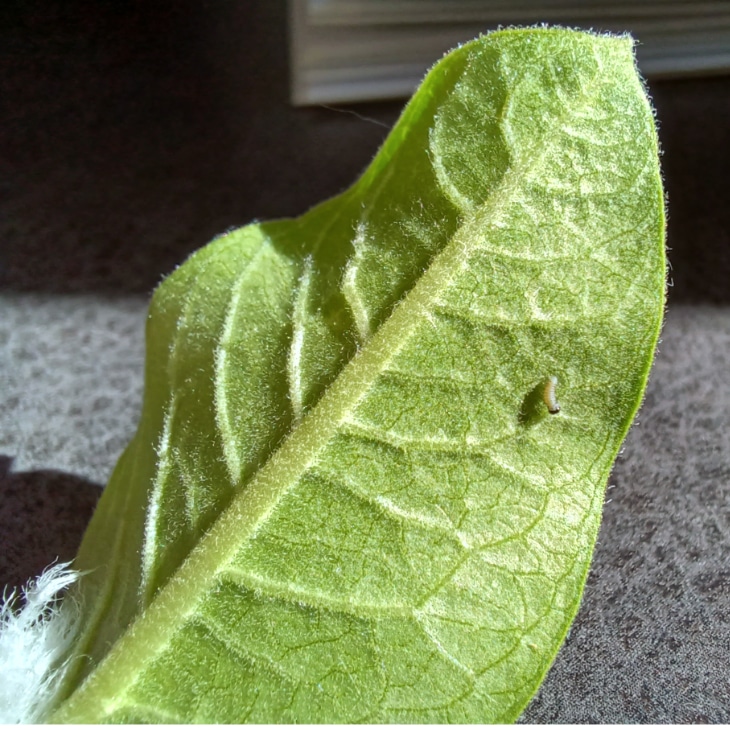
Monarch larva have five special growth stages called “instars.” Isn’t that a great term?! This little larva is in the first instar. Monarch Butterfly Life has a great page about the instars along with a great picture of a first instar caterpillar munching on their egg as their first meal.
Actually, all monarch larva do the exact same thing once they emerge from their eggs. They take a few steps away from it, raise up the first half of their body like they’re taking it all in, and then turn around and eat their protein-rich egg to give them the energy to find their first milkweed meal.
In my years of raising monarchs, I’ve only witnessed this process twice. The second time I had a magnifying glass, and it was incredible to observe.
While I didn’t catch my larva’s hatching, I knew there was a great video by MrLundScience where you get a front row seat to what happens:
Now it’s time for this larva to get growing: they will grow to almost 2,000 times their current mass. Eric Carle nailed it when he wrote The Very Hungry Caterpillar. Well, not perfectly since he confuses chrysalises for cocoons – but we’ll get to that later.
Wednesday, May 31st
Our little larva is another instar older! Each instar lasts approximately 1-3 days where they eat and eat until they are no longer be comfortable in their skin (or exoskeleton). Then they molt their outside layer and then eats it (larva don’t have the luxury of wasting a healthy meal).
This is when they begin to resemble what you think of when you think of a monarch caterpillar. They get their first face cap, stripes, and little nubs for tentacles. And yes, the term is tentacles and not antennae. Antennae are what they have when they are butterflies.

The amazing thing (among many) is that already the caterpillar has begun internally developing what will be the butterfly. The only external part of its body that will remain are its six feet.
You may also notice the “frass” in this photo: those little dots near the stem of the milkweed leaf. That’s the scientific name for caterpillar poop! This frass is great to add to the garden soil, though it makes more sense to add it to soil once it’s bigger. I’ve actually witnessed 4th and 5th instar larva picking up their frass and tossing it out of the way: they like their leaf to be clean.
One more thing that I’ll point out is that it won’t be until the 3rd instar that the larva’s mandible will be big and strong enough to eat all of the milkweed leaf. Until then, they make do with chewing holes in the softer sections.
In my next update, I’ll share with you how you can become a citizen scientist and help the monarchs.
June 1 – June 9
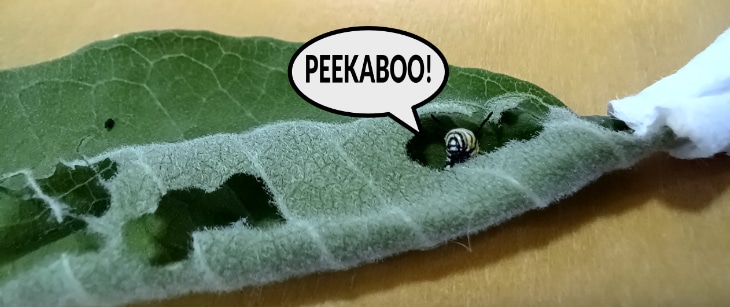
Well, this mini-mania needs a MEGA update. Things have been extra-busy at the library, and I had to prioritize other things over updating this series. But, I finally have some time to share with you the rest of this caterpillar’s journey.
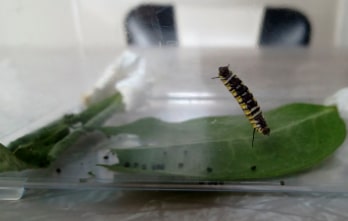
This little larva did what all larvae do best: eat!
After awhile (usually between 1-3 days) the caterpillar must molt their tight skin. It’s looks sort of like when you take off knee-high socks.
When I raised my first monarch, the precursor to molting took me by surprise, and I was worried that the little guy was sick.
Suddenly, the larva was spending a lot of time upside-down! But I soon realized (after checking some online sources), that this is the best position to be in when molting. The larva can walk forwards, with the help of gravity, to leave both their skin and face cap behind.
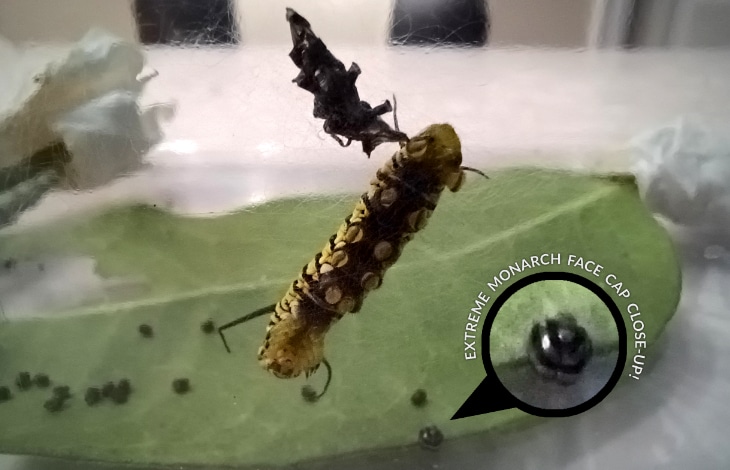
There are so many things I could point out in this picture (like check out how much longer their fresh-yellow legs are compared to their former black-tipped feet), but I think that the face cap is one of the cooler things.
Once it feels up to it, it returns to its all-it-can-eat milkweed buffet. Observing their munching can be a very relaxing pastime.
The larva has FIVE of these instars in about two weeks. Basically, they grow 2000 times larger than when they began. That would be like an average sized human baby growing to be 3,333 feet tall in two weeks!
I tried to find a visualization of this growth online, but had to go ahead and create my very own using the Eiffel Tower as a size reference.
It may not be 100% accurate, but it’s close.

Here’s our wigglebottom on their fifth, and final, instar:
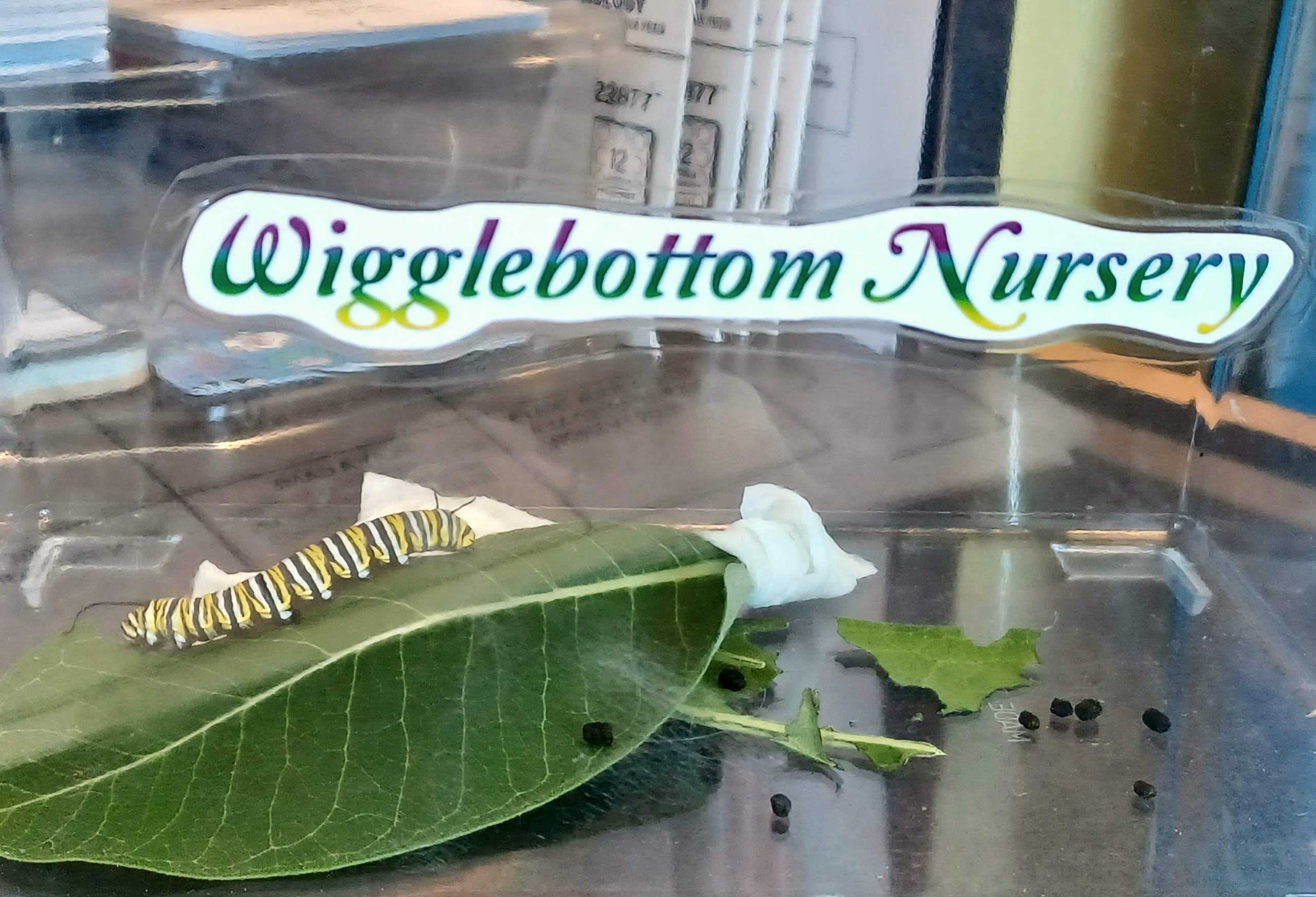
Aren’t they beautiful?!
There a so very many things that I could share with you about this. Seriously. I can sound like a 1st grader who is super into dinosaurs, although I’m a middle-aged woman who is super into monarchs. But I’ll jump ahead to the next big transformation: the pupa stage!
June 10
This is what a lot of people don’t quite understand: butterflies don’t make cocoons, they become chrysalises. To make it a bit clearer: cocoons are created by wrapping things around a critter (like with moths), and a chrysalis has been inside the caterpillar the whole time.
I missed videoing this caterpillars transformation by less than a minute! I am still mad about that, especially because I knew it was going to happen at any moment.
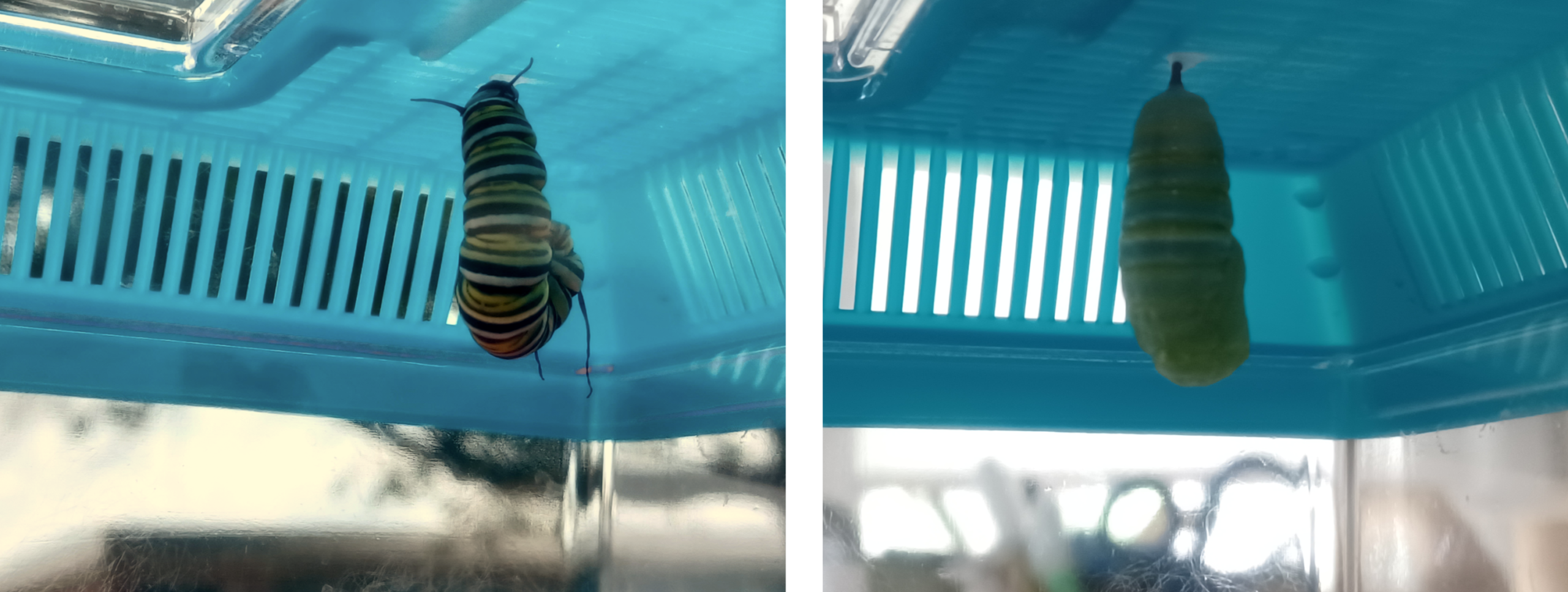
Thankfully, I found a very nice photo of this that’s a little less intense than a video:

So it’s like the caterpillar took off a zippered dress that they then throws on the ground. After a little while, the chrysalis hardens, and then mysterious things happen. Seriously. Scientists are still trying to figure out what happens during the 10-14 days that the pupa takes to become a butterfly.
One of the neatest things that I learned as an adult, is that the chrysalis isn’t green: the chrysalis is CLEAR. That still amazes me. It looks like the chrysalis becomes dark right before the butterfly emerges, but it’s actually the final stage of its metamorphosis: the colored pigments wash through the butterfly.
June 23
Our little wigglebottom took the entire 14 days to eclose. “Eclosing” is the correct scientific term for what a lot of people call “hatching.”
I did not catch our pupa’s eclosure into a flutterbutt. I try to remind myself that this quick transition is another reason why it took humans a long time to figure out that what started as caterpillars eventually transformed into butterflies. Many times I wonder about the first people who made that connection, and how much it must have blown their minds. And then they’d have to convince others that this was a real thing.
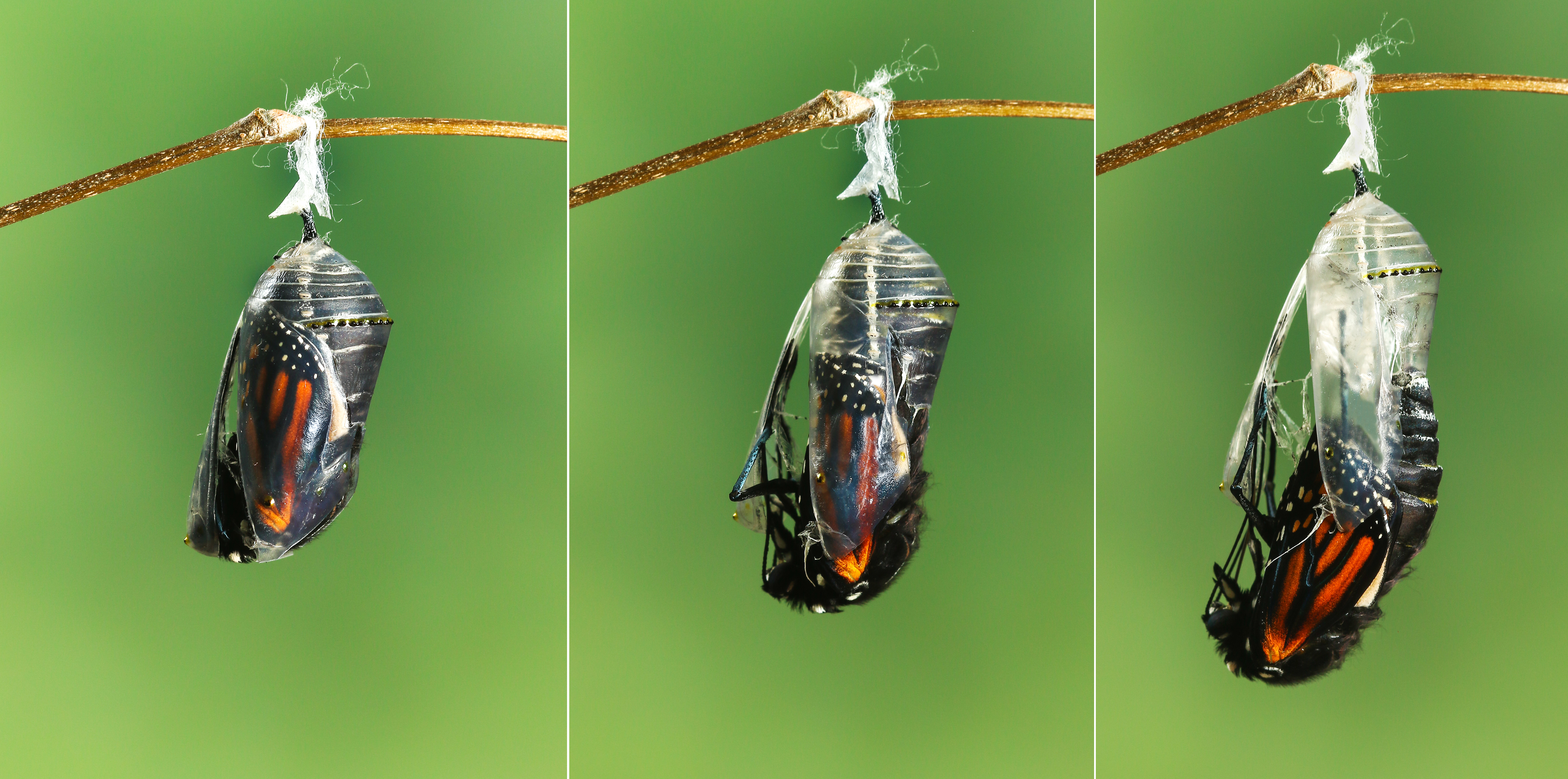
I had left the nursery at work on June 22 since I was concerned about harming the butterfly in this final stage. And so when I arrived at work, both Allana and Angelica were both excited to tell me that the butterfly had arrived!

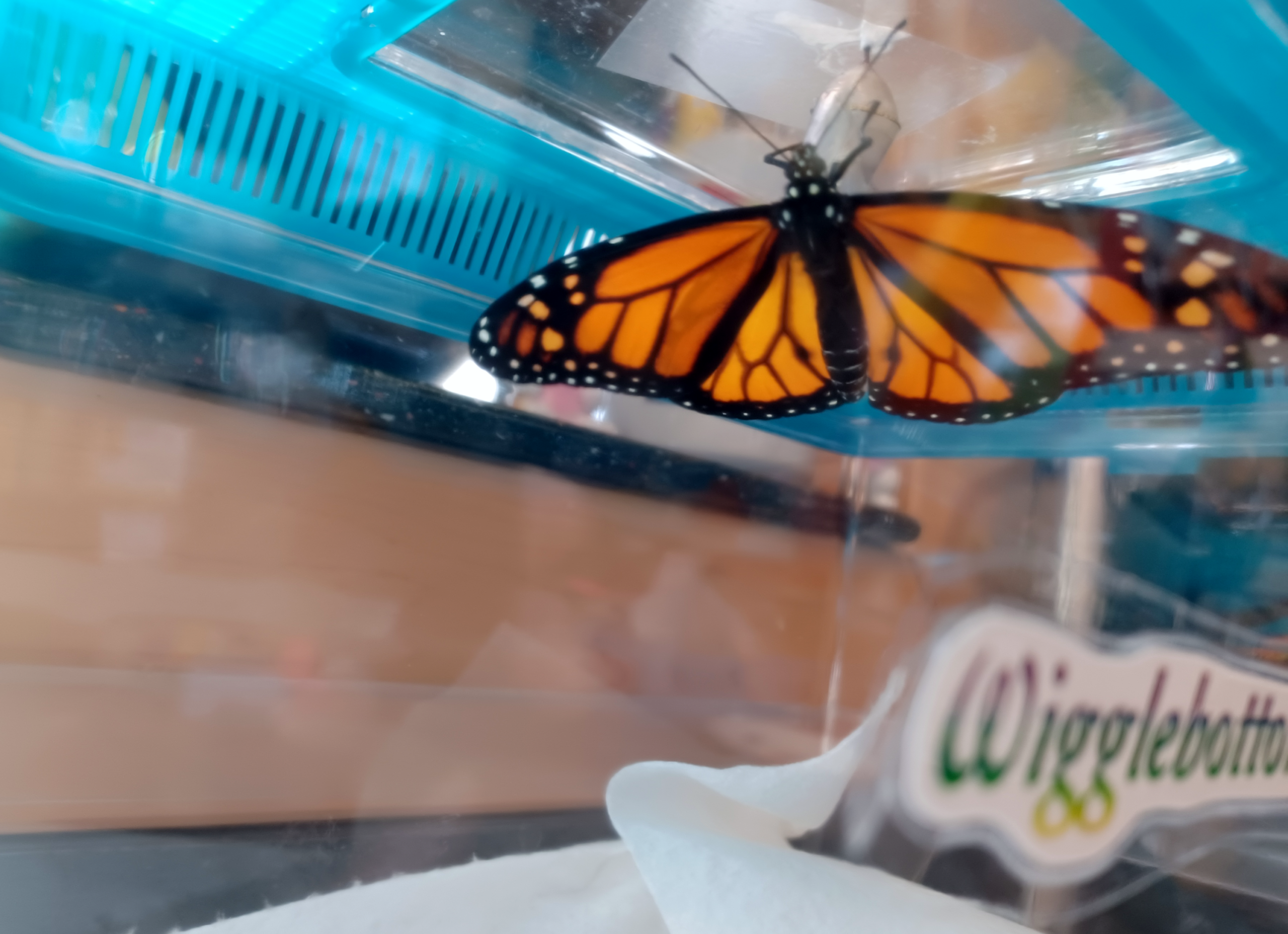
How did I know that this monarch is male? Below is a picture of a female (on the left) and male (right) monarch butterfly. Can you spot the differences between the two?
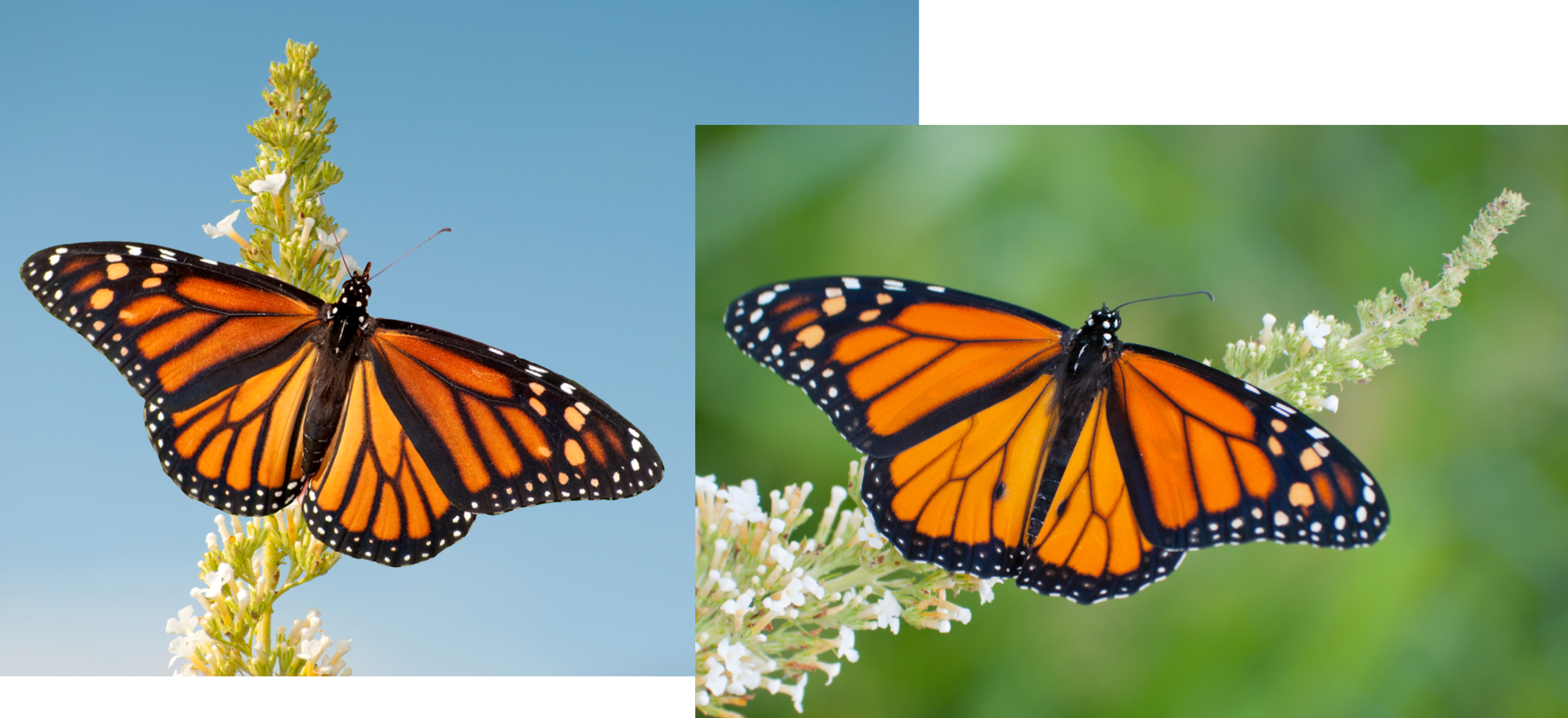
Finally, after the butterfly’s wings had dried for a little over three hours, the weather was nice enough to release him. Allana, Angelica and I carefully took the nursery outside and found a good spot where he could safely begin his new journey. After all, he previously could only see light and dark, and didn’t have wings. Now his world was technicolor and full of new tastes and sensations.
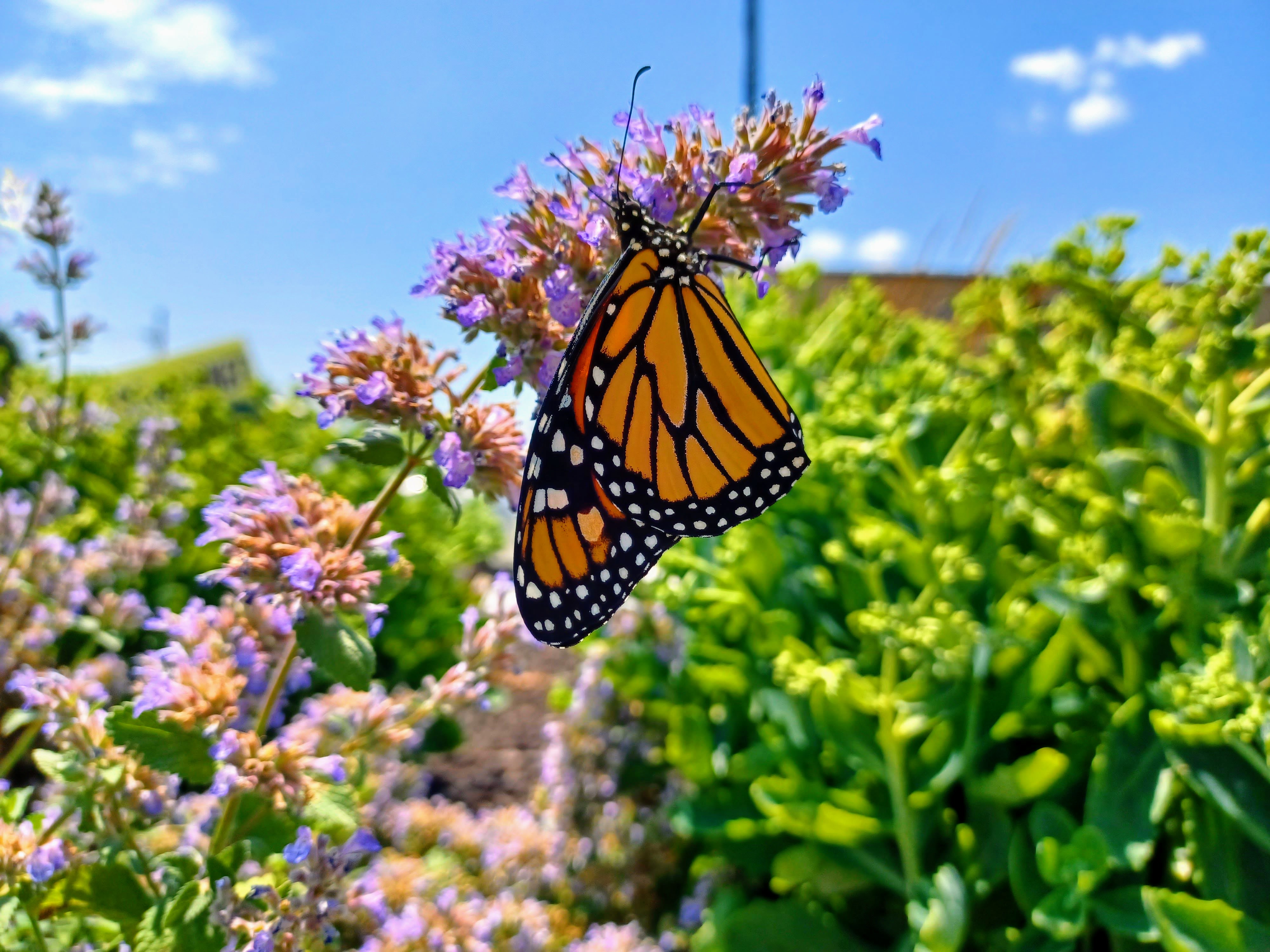
Next year if I find another monarch egg in my garden, I will do another series on raising them. Hopefully I’ll have a chance to keep the timeline current. If not, then maybe I should look into getting a “monarch cam” and live stream it.
I’m skipping over a ton of great monarch facts: from their multi-generational migration, to super monarchs! There’s a lot you can discover about this awesome insect both online and at GPL. Know that I’m always happy to drop almost anything to talk about monarchs, so you can email me at the library or just ask me when I’m around either building.
You can also become a citizen scientist to help the monarchs – read on to find out how!
Become a Citizen Scientist
If you haven’t noticed by now, then I shall point you in this marvelous organization’s direction: Monarch Joint Venture. I get their newsletter with all of the monarch news you could ever want – from the good to the bad news, they share it all.
They have an incredibly comprehensive list of different organizations where you can donate your time or money to. But to become a citizen scientist, it involves your time. Some of the easiest ways to help the science of this species along is by reporting observations, such as when you first find a milkweed plant that year, or egg, larva, pupa, or adult! Some organizations like to share your pictures as well.
Journey North is where I report my sightings as well as receive their newsletter. I also have a small recurring donation to the UW Arboretum‘s monarch research.
Do you enjoy running, walking, or hiking – either solo or with a team? Then you can participate in the Miles for Monarchs program that spreads both awareness and fundraises for the Monarch Joint Venture.
Even learning more about monarchs qualifies you as a citizen scientist. For example, I just read an amazing article on npr.org about how scientists at the University of Georgia believe that the white spots on monarchs help them to migrate!
How to Best Help the Monarchs
The best way for you to help the monarchs is by planting milkweed, milkweed, and more milkweed.
You can get seeds from many online nurseries. I’ve gotten mine from Nebraska’s own Stock Seed Farm. Common Milkweed is the largest of the bunch.
This summer I purchased one of the milkweed plant kits from Monarch Joint Venture/Minnesota Native Landscapes, and all of my plants have survived so far (which for me is pretty amazing).
You can also find some milkweed plants at local nurseries.
Have a friend who has milkweed? You can have them harvest seed pods before they release.
Thank You
Finally, I want to thank those of you who have read (or even just skimmed) this series. I hope that you had a few laughs, and learned something new. And I hope that you become a monarch advocate who will help spread the support for this beautiful insect.

